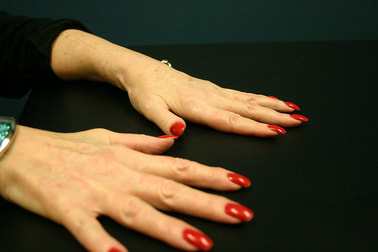Osteoarthritis
Once osteoarthritis starts to set in, it is important to protect the joints from further wear-and-tear and joint stress by using adaptive equipment, incorporating joint protection techniques into your activities, and using splints and orthotics to support the joints in healthier positions.
What is Osteoarthritis?
What is Osteoarthritis?
- Osteoarthritis is the wear-and-tear of the nice, smooth articular surface that coats the end of bones and allows the two bones of a joint to slide easily upon each other with movement.
- When the cartilage breaks down, the bone surface becomes becomes uneven, bone spurs may develop, and the joint space between the bones is lost.
- Pain occurs when the bones start rubbing against each other.
- The joints can become swollen and stiff.
- The joints can also change position, become unstable, or become misshapen.
- Common areas for arthritic bumps, or nodes, to develop are at the joint towards the tip of the finger (Heberden's Nodes) and at the middle joint of the finger (Bouchard's Nodes).
- Use of orthotics, splints or braces to position the finger joints in proper alignment and to support the joints during activity.
- Implementing Ergonomic Improvements & Activity Modification
- Use of gadgets and devices (adaptive equipment) to make tasks easier with less stress on the joints.
- Using modified techniques to place less stress on the joints (joint protection).
- Modifying the flow and pace of how activities are performed in order to minimize muscle fatigue, joint stress, and pain (energy conservation).
- Use of Heat and cold
- Use cold packs for acute pain or swelling.
- Use heat packs to control more chronic pain or relax the muscles.
- Wearing compression or Isotoner gloves or finger sleeves at night may help control swelling and provide a comforting, neutral warmth.
- Perform gentle ROM exercises to keep joints flexible.
- Use of topical pain relieving creams if helpful and as needed.
- Modalities such as ultrasound and paraffin application may be helpful to reduce pain and inflammation.
- Therapeutic taping may be helpful to reduce pain and provide gentle support.
- A short course of anti-inflammatory medications, such as NSAIDs, may be helpful as prescribed by an MD or over-the-counter (Advil, Aleve) if not contraindicated by other medical conditions.
- If conservative treatment methods do not alleviate the symptoms, surgical options may be considered.
- American Society of Hand Therapists (ASHT) - PDF Educational Handout
- American Society for Surgery of the Hand (ASSH) - Website Information
- American Academy of Orthopaedic Surgeons - Website Information
- Techniques to Reduce Joint Pain (ASSH Hand Care Blog) -6 minute video, advice from a hand therapist
- Arthritis Foundation - "Tools & Resources"
- Arthritis Foundation - **Ease of Work products listed by category (health & wellness, home & hobby, work).
- **The Arthritis Foundation’s Ease of Use Commendation recognizes products proven to make life easier for people who have arthritis and other physical limitations.
- **The Arthritis Foundation’s Ease of Use Commendation recognizes products proven to make life easier for people who have arthritis and other physical limitations.
Proudly powered by Weebly
